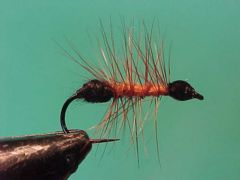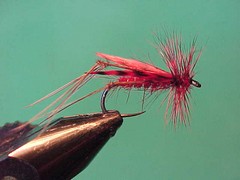Dry flies
{{start}}
I reserve my dry fly selection for flies that are fished on the surface of the water and either represent the dun or spinner of a an insect that spends part of its life cycle in the water such as a Mayfly, Caddis fly, Midge, Dobsonfly, Cranefly etc. or they represent terrestrial insects that have fallen or have been blown onto the surface of the water. I have separate page for my hoppers and emerger type flies each of which I also carry in my ‘Dry fly box’.
{{end}}

{{+1}}Hackled gold ribbed hares ear{{-1}}
{{start}}
On balance I think it fishes better than the Greenwells Glory. It works equally well on running or still water and is a little more buoyant than the Greenwell Glory and is buoyant enough to support a small bead head nymph in a wet under dry team.{{end}}

{{+1}}Plume{{-1}}
{{start}}
This is an incredible fly for delicate presentations to mayfly feeders ... the waters of the Korka had mayfly hatching but I was having trouble in finding a fly that didn’t spook them. Remembering that browns were behaving in a similar way in the training session I mentioned above I swapped over to the plume and ultimately did pretty well for the session coming in 10th out of 28 competitors.{{end}}

{{+1}}Ant – Chatto’s original Palmered ant{{-1}}
{{start}}
If it's a hot day, a warm balmy night, if water is rising over previously dry ground or almost any time for that matter you can get huge hatches of ants. They vary in colour but the dominant hatches are of black meat ants and banded sugar ants.{{end}}

{{+1}}Rat faced McDougal{{-1}}
{{start}}
This appears to be an American fly designed by Harry and Elsie Darby (or Darbee), the famous fly tiers of Roscoe, New York. The story goes that a friend of theirs, and several names have been put forward including Percy Jennings, an amateur fly tier from Cold Spring Harbour and Carl Otto von Kienbush a well known New York angle asked them to design a highly visible and buoyant dry fly.{{end}}

{{+1}}Claret hopper{{-1}}
{{start}}
A popular fly in the United Kingdom this fly is equally at home early and late in the season in Australia. We don't have any burgundy coloured hoppers that I am aware of but this buggy looking fly often works when the first and last of the seasons terrestrials are around. Whilst not a strong floater this fly ticks all the boxes for those that want an enticing fly that will sit in the surface film.{{end}}

{{+1}}Tea tree beetle – variant 2{{-1}}
{{start}}
Both floating and wet beetles (including drowned terrestrials beetles and aquatic beetles) should be fished in the current with as little line drag as possible or with a very short twitching action. A nondescript well tied beetle pattern if presented in the right way when fish have beetles on their menu, more often than not, will be accepted by fish.{{end}}

{{+1}}Tea tree beetle – variant 1{{-1}}
{{start}}
One species that is a popular food source for trout is the tea tree beetle. This representation is tied in shades of black and brown colours that have stood the test of time. Many of the recipes you see use brown raffia as the wing case. I don't like raffia as a fly tying material and have substituted a hackle from the back of the ring neck pheasant. Its a similar colour to many of the recipes that have come before mine but its much more durable than the raffia.{{end}}

{{+1}}Geehi beetle{{-1}}
{{start}}
One of the key elements of this fly that has been overlooked in many fly patterns I have seen id the choice of the front hackle. Make sure its a 'cocky-y-bonddu' type hackle i.e. a ginger hackle with a black centre. The black centre of the hackle when wound in touching turns to the eye of the hook extends the beetle body along the full length of the shank of the hook and I an confident that is one of the keys to the success of this fly.{{end}}

{{+1}}Foam hopper – Chatto original{{-1}}
{{start}}
If you fish fast water and need a very buoyant hopper or a buoyant fly to support a nymph try this one.{{end}}

{{+1}}Claret daddy{{-1}}
{{start}}
This is a cross between an English claret hopper and a daddy long legs fly and it fills a gap in my fly box for a buggy looking search pattern when there are a few terrestrials about but no clear consistency of species. Because of its size and the way that it floats this fly is also useful as a top fly when either Loch Style Dry Fly fishing or as an indicator when fishing a team of dry smut flies or other small flies.{{end}}













